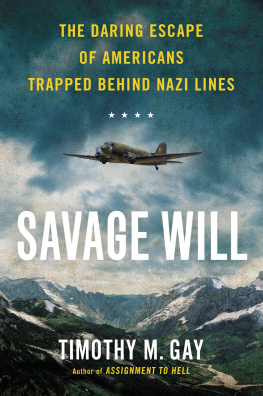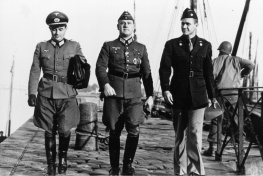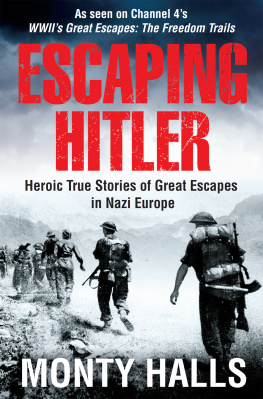ESCAPING
HITLER
Heroic True Stories of
Great Escapes in Nazi Europe
MONTY HALLS
PAN BOOKS
To my dad,
who served his country,
and to Isla and Molly,
who I pray never have to witness
the horrors of conflict
CONTENTS
PREFACE
It is not unreasonable to assume that the desire for freedom is universal, something fundamental to us all. Surely, when faced with a choice between imprisonment and liberty, simple human nature means that we would do whatever it takes to slip the bonds of captivity. But in researching this book, it became apparent that such decisions are seldom simple.
Time and time again, when I met the few remaining survivors of the Freedom Trails of the Second World War, I recognized an indomitable spirit which meant that they often defied logic, the enemy, the elements, and even their companions to take their fate into their own hands. It is only in trekking the trails that one realizes the physical challenge involved (and for most I only did key sections of the entire routes). Frequently, the escapees would arrive at the start of the main Freedom Trail for example over the mountains of the Pyrenees having already been on the run for several hundred kilometres over the course of many months. They were so often pitifully ill-equipped, malnourished and under immense mental strain, and yet they still had what it took to take on formidable natural features that required the skills and endurance of mountaineers.
Such independence of thought and action has also been readily apparent in the people who helped them on their way the vast majority of escapers fully acknowledge that without local assistance and support, they would not have had the slightest chance of regaining their freedom. The courage of the local people who did offer this assistance is beyond debate, as they invariably faced brutal reprisals if captured. Despite the huge risk to themselves, they still gave everything they had in order to help complete strangers. To a large degree, they are the heroes of these stories.
They are old men and women now, those who remain to tell their own tales of escape or defiance of their enemy in an occupied land. But despite the passage of time, this crystal spirit still shines brightly. Although invariably modest and unassuming (Anyone would have done it is a recurring theme in most interviews), they do speak proudly of their deeds, wearing them as a badge of honour and a defining moment in their lives. Under the most pressing of circumstances, they werent found wanting. How many of us faced with similar, near impossible choices would have shown the same strength of character?
Although such individual qualities are a continual theme in this book, the four main escape stories present contrasting circumstances and environments. The SAS raid in the Rossano Valley in Italy tells the tale of an extraordinary group of men exfiltrating through a benighted and stricken landscape (the SAS never retreat, they exfiltrate. I was reminded of this with some vigour by a modern Special Forces contact!). By stark contrast, the exploits of a young man from Hackney one who had never left England before the war began in not only living covertly in the midst of the German occupiers, but then making a heroic bid for freedom over the immense white wastes of Monte Amaro, represent a monument to an indefatigable will to survive as well as great personal initiative and drive. The Crows Flight in Slovenia is truly one of the most remarkable escape stories of the entire war the largest successful escape by Allied POWs during the conflict, and a feat of leadership by one man that rings through the ages. And finally, there are the Pyrenees escape lines immense in their scale, both logistically and geographically. One in particular, the Pat OLeary line, was run by a man who was truly a colossus in the annals of escape and evasion. These are routes that the Nazis never truly conquered, operating with a local support network that they never fully subdued.
As a former Royal Marine myself, it was absolutely fascinating to investigate the physical, moral and mental challenges that faced the individuals who moved along these trails. Like so many of my generation, I have never been pursued, harried and hunted by a relentless and well-equipped enemy. I have never lived in fear of my life through a simple accident of time and place, of ethnicity and of culture. To walk these trails through some of the most dramatic landscapes in Europe is all about perspective we are indeed blessed, with so much of what we have today owed to the sacrifices of those who have gone before. I felt dwarfed by the immensity of the scenery around me and awestruck at the stoicism and bravery of the people who played out their roles against the backdrop of the Second World War. I urge you to attempt some of these walks yourself, to follow the stories, and to experience just how far we have come as a continent since those dark days. In this new age of mass migration, of the movement of desperate groups of people into unknown lands, the stories of the Freedom Trails truly resonate. They offer a template for the very best, and the very worst, of human nature.
I will finish with my own small tribute to the men and women who used these trails, as well as those who bravely maintained the networks and infrastructure around them. Your stories are truly inspirational, it has been my pleasure to meet you, and my great privilege to walk in your footsteps.
Monty Halls
PART ONE
The Promise of Freedom
Pyrenees, France
Freedom is not a gift from heaven one must fight for it every day
Simon Wiesenthal
CHAPTER ONE
Escapers and Evaders
Per Ardua Libertas
Through Hard Work, Liberty
The title of a photographic survey of MI9s work, produced by Christopher Clayton Hutton, and issued to MI5 and MI6 (SIS) in an edition of fewer than one hundred in 1942
In war, ordinary people are called upon to do extraordinary things, and are thrown into situations and circumstances so totally unfamiliar that they must learn fast if they are to survive. In the case of prisoners of war, they may have had virtually all of their rights removed, and their rank, honour and dignity stripped away by incarceration. But they could still maintain a flicker of hope they could plan their escape. As Viktor Frankl notes in Mans Search for Meaning: Everything can be taken from a man but one thing: the last of the human freedoms to choose ones attitude in any given set of circumstances, to choose ones own way.
During the war, many prisoners exercised this right, but not as many as one might expect. Although there was an unspoken code amongst Allied soldiers that they should always seek a means of returning home and from there go back to the battle, for some, incarceration offered a way of seeing out the war in relative safety. Many men simply did not have the heart for an escape attempt. Others had skills which were indispensable in aiding other escapers, and therefore remained in the camps to assist their compatriots: the forgers of passports and other documents, the coders, the organizers and creators of escape aids. There were also those few who actively collaborated with the enemy, such as the traitor Harold Cole a key character in one of the more compelling stories of the freedom trails. Indeed, there were occasions where POWs were actively discouraged from escaping for example after the Italian surrender of September 1943, senior officers ordered prisoners to stay put in their camps until the Allied advance could liberate them.











